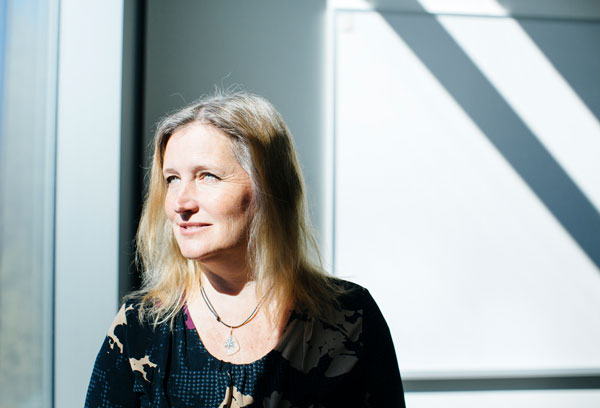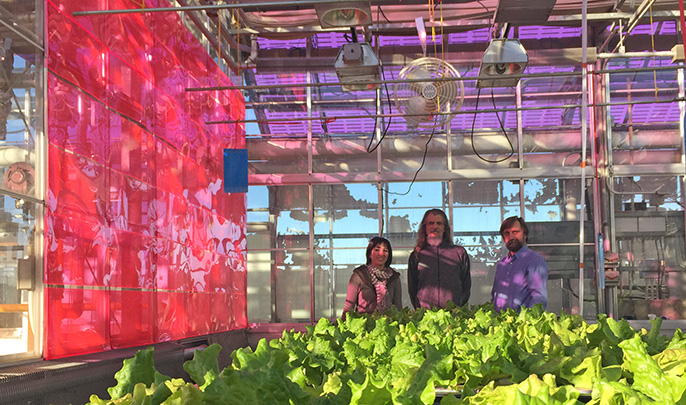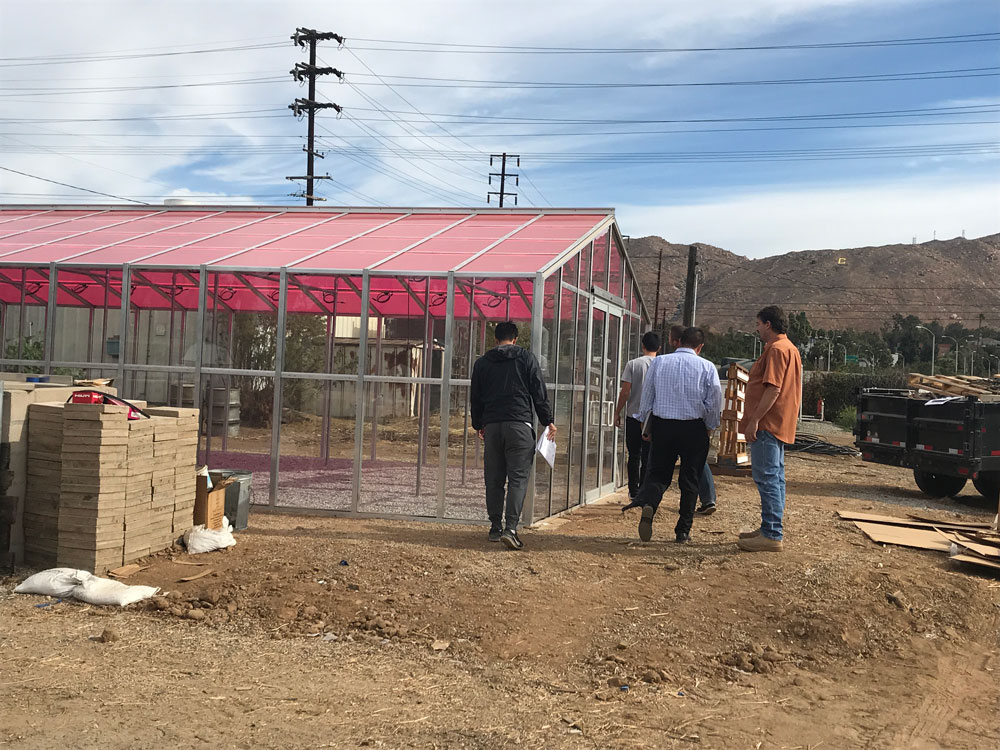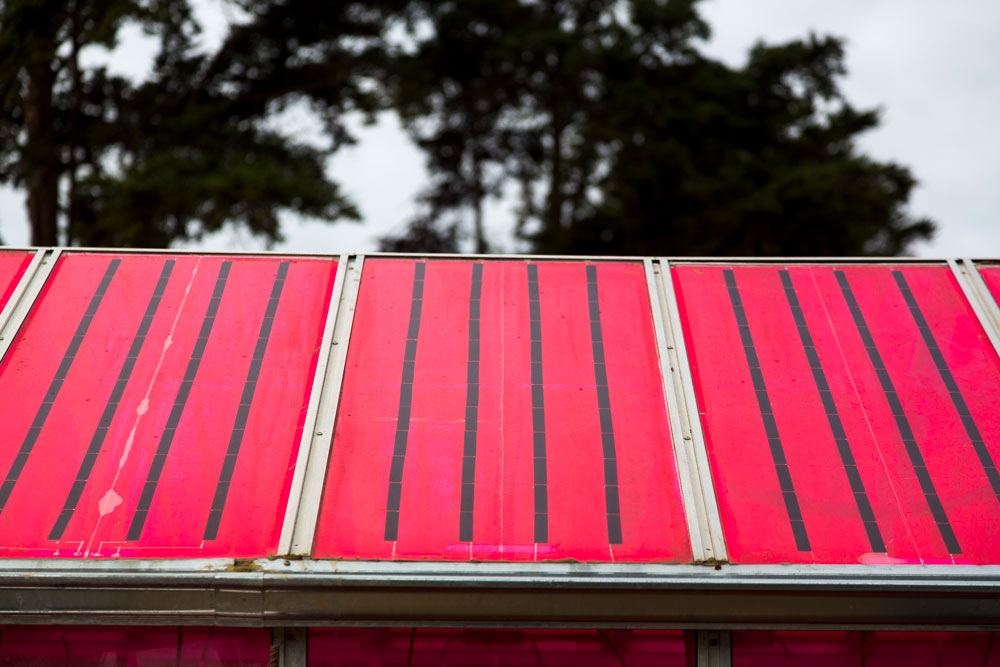Greenhouses have a long list of benefits: higher food production, less water use, potentially less pesticide use, a year-round growing season. There’s a problem: they’re expensive, both to install and to operate. But thanks to solar technology developed at UC Santa Cruz, greenhouses are enjoying a new moment in the sun.
Soliculture, a company based on technology developed in the Thin-Film Optoelectronics Laboratory of physics professor Sue Carter, has been busy explaining to growers the benefits of using their solar panels on greenhouses.
“To put it simply,” said Glenn Alers, CEO of Soliculture, “Soliculture panels allow more power, more produce, more profits.”
The panels themselves are not what you expect when you imagine a solar panel: they’re translucent, and they’re a bright shade of magenta.
How magenta makes greenhouses greener
The idea to apply transparent solar panels to greenhouses came about as a happy accident.

Sue Carter
Carter and her research team were working on luminescent solar concentrators, which use a fluorescent dye to absorb light and make solar panels significantly more efficient.
“The concentrator dye absorbs the sunlight and then re-emits it as lower energy photons. This means you can use a lot fewer solar panels, because the absorber is doing the work,” explained Carter.
No system is perfectly efficient, and there’s always light that doesn’t get used by the solar panel and is lost. In this case, there was something interesting about the rosy-colored light being lost from the panels they were testing. This light wasn’t waste: it was fuel.
“We realized that the red color of the light was exactly what you see in commercial grow lamps for plants,” Carter said.
Plants don’t use the entire spectrum of visible light for photosynthesis — grow lamps optimize the colors of light that plants actually use to grow. The solar panels developed in Carter’s lab absorbed green light and emitted red light to enhance the power generation of the solar cell — and the excess red light happened to fall exactly in the range of the spectrum that plants use.

Soliculture’s director of engineering and UC Santa Cruz alumna Melissa Osborn, with members of the Alberta Innovates-Technology Futures team, conducting trials of Soliculture’s solar panels in a lower light location.
Benefits of a solar greenhouse
The biggest barrier to greenhouse adoption is cost, including the cost of installation and materials, and the ongoing cost to cool, heat and light the greenhouses. Using solar panels to generate electricity dramatically lowers the cost of powering a greenhouse. Carter and Soliculture are working now to show that a fully net-zero greenhouse is possible.
“California is one of the biggest users of greenhouses in the country — if not the biggest, and it will only get bigger,” said Carter, citing as two drivers the California drought and increased demand for organic produce.
A net-zero greenhouse is easier to achieve if you’re in a temperate climate along the coast, like UC Santa Cruz. But what about other, drier areas of California, like the Central Valley or Inland Empire?
At UC Riverside, making pink solar greenhouses scalable across climates is the goal. “We have to make sure it’s sustainable,” says Peggy Mauk, director of agricultural operations and subtropical horticulture specialist at UC Riverside. “We can show it doesn’t have to be used only in a coastal environment. We can use it in most of California.”

UC Riverside's new solar greenhouse.
To build their pink solar greenhouse, UC Riverside engineering groups pitched in, donating lithium ions. They want to see if the greenhouse can handle the often withering conditions (up to 140 degrees Fahrenheit sans cooling in a greenhouse in Southern California) without adding extra panels. Here again, the color of the panels is helpful. Not only do the panels provide electricity to power swamp coolers, but the colored shading of the panels keeps greenhouses cooler and can eliminate the need for blinds.
Up and fully functional soon, UC Riverside’s solar greenhouse takes its place in a larger complex of UC Riverside sustainability projects: a student garden and solar farm. “It’s beautiful,” says Mauk, and the end product will hopefully be even better — an out-of-the-box solar greenhouse model that can be used for crops and research across the state, a “showcase for UC carbon-neutral greenhouse production.”

A close-up of the panels used in the solar greenhouse.
Green innovation grows at UC
Soliculture isn’t the only company seeing green in going green; they’re part of a large crop of startups and green technology innovations to emerge from UC research in recent years.
“Right now is the perfect time for entrepreneurship in green technology,” said Carter.
Startups like Tule Technologies based on UC Davis technology are helping California growers adapt to limited water supplies, and clean energy startups from wave energy to next-generation battery manufacturers are emerging out of UC inventions at a rapid pace.
“Normally it takes a long time to move from idea stage to market,” said Carter, “but right now a combination of beneficial policy changes, natural disasters, and lifestyle changes are accelerating everything.”

